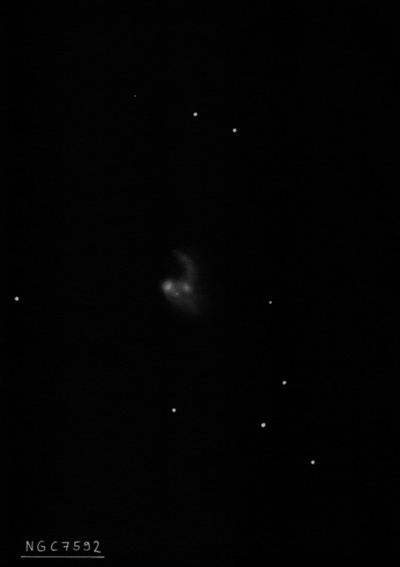
William Herschel discovered NGC 7592 = H III-186 on 20 Sep 1784 (sweep 279) and noted "eF and vS." Heinrich d'Arrest measured an accurate micrometric position on 2 Oct 1866.
400/500mm - 17.5" (8/7/91): faint, small, round. NGC 7592A, a very faint and extremely small companion (only the nucleus was observed) attached at the west edge, was just resolved. NGC 7585 lies 17' SW. This is an interacting/colliding pair on the POSS with nuclei only 15" apart!
600/800mm - 24" (8/23/14): at 375x appeared fairly faint, fairly small, irregular. The component with the highest surface brightness is the core of the eastern galaxy (NGC 7592B = 7592E). Most of the glow extended southwest (NGC 7592C = 7592S) and created an asymmetric appearance. The nucleus of the western galaxy (NGC 7592A =7592W) appeared faint and extremely small, perhaps 5" diameter. The arm or wing to its north was not seen. The two nuclei are separated by only 13". The nucleus of the third southern component, which wasn't seen, is probably a large HII clump in NGC 7592E. The western galaxy has a Sy2 nucleus.
900/1200mm - 48" (10/29/19): NGC 7592 is an interacting, merged pair with a separation of only 13"! At 610x the western component (NGC 7592 W) appeared moderately bright, small, round, with a sharp stellar nucleus. A low surface brightness tidal arm was attached on the west side and it hooked to the north. The brighter eastern galaxy (NGC 7592 E) was fairly bright, fairly small, roundish, ~25" diameter, very bright core offset towards the north side. A very small HII knot, 6"-8" diameter, called NGC 7592 S, is at the southwest end [13" from center]. A very low surface brightness halo extended further southwest of 7592 E and directly south of 7592 W. This section is probably part of another tidal tail.
Notes by Steve Gottlieb